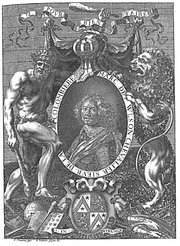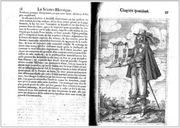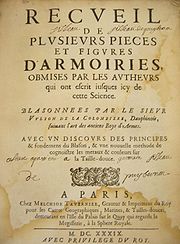
Marcus Vulson de la Colombière
Encyclopedia

He published several highly successful books on symbol
Symbol
A symbol is something which represents an idea, a physical entity or a process but is distinct from it. The purpose of a symbol is to communicate meaning. For example, a red octagon may be a symbol for "STOP". On a map, a picture of a tent might represent a campsite. Numerals are symbols for...
s, prophecies
Prophecy
Prophecy is a process in which one or more messages that have been communicated to a prophet are then communicated to others. Such messages typically involve divine inspiration, interpretation, or revelation of conditioned events to come as well as testimonies or repeated revelations that the...
, heraldry
Heraldry
Heraldry is the profession, study, or art of creating, granting, and blazoning arms and ruling on questions of rank or protocol, as exercised by an officer of arms. Heraldry comes from Anglo-Norman herald, from the Germanic compound harja-waldaz, "army commander"...
, dreams etc. He put together all the available knowledge and traditions associated with chivalry
Chivalry
Chivalry is a term related to the medieval institution of knighthood which has an aristocratic military origin of individual training and service to others. Chivalry was also the term used to refer to a group of mounted men-at-arms as well as to martial valour...
. In the 17th century chivalry was practically rediscovered by two genealogists and sycophants in the French court: Colombière and Claude-François Ménestrier
Claude-François Ménestrier
Claude-François Ménestrier was a French heraldist, a member of the Society of Jesus [Jesuit], and attendant of the royal court....
after its golden age (1100–1400) and the decline of chivalry, developing its idealized image. Some authors named de la Colombière as the inventor of hatching system
Hatching system
The system of heraldry has two main methods to designate the tinctures of arms in uncolored illustrations: hatching and tricking. Hatching, i.e. patterns of lines and dots, is the most common method to designate colours on uncoloured surfaces, like engravings, seals and coins.The present day...
of tinctures.
Biography

Dauphiné
The Dauphiné or Dauphiné Viennois is a former province in southeastern France, whose area roughly corresponded to that of the present departments of :Isère, :Drôme, and :Hautes-Alpes....
. He was a son of Francois, advocat and Michelle Odde de Bonniot. In his youth, he fought for Henry IV. According to a curious anecdote, in 1618 he went to Paris to request grace, after he killed his treacherous wife and her lover.
According to the title pages of his books, (see for example Le Vray Théâtre d´honneur et de Chevalerie, Paris, 1648), he was a member of parliament
Parliament
A parliament is a legislature, especially in those countries whose system of government is based on the Westminster system modeled after that of the United Kingdom. The name is derived from the French , the action of parler : a parlement is a discussion. The term came to mean a meeting at which...
(self-government) in Paris
Paris
Paris is the capital and largest city in France, situated on the river Seine, in northern France, at the heart of the Île-de-France region...
and the member of the Order of Saint Michael
Order of Saint Michael
The Order of Saint Michael was a French chivalric order, founded by Louis XI of France in 1469, in competitive response to the Burgundian Order of the Golden Fleece founded by Philip the Good, duke of Burgundy, Louis' chief competitor for the allegiance of the great houses of France, the Dukes of...
(gentilhomme de la Chambre du Roi et Décoré de l’Ordre de Saint-Michel). By all probability, until 1635 he was staying in Grenoble
Grenoble
Grenoble is a city in southeastern France, at the foot of the French Alps where the river Drac joins the Isère. Located in the Rhône-Alpes region, Grenoble is the capital of the department of Isère...
as he was a royal counselor in the Dauphiné parliament (conseiller du roi en la cour de parlement de Dauphiné). He also published a book in the spirit of the Gallicanism
Gallicanism
Gallicanism is the belief that popular civil authority—often represented by the monarchs' authority or the State's authority—over the Catholic Church is comparable to that of the Pope's...
in Geneva
Geneva
Geneva In the national languages of Switzerland the city is known as Genf , Ginevra and Genevra is the second-most-populous city in Switzerland and is the most populous city of Romandie, the French-speaking part of Switzerland...
that year. (It can be noted that several of the Protestant priest
Priest
A priest is a person authorized to perform the sacred rites of a religion, especially as a mediatory agent between humans and deities. They also have the authority or power to administer religious rites; in particular, rites of sacrifice to, and propitiation of, a deity or deities...
s and students at the Geneva University were his kinsmen.) Gallicanism served as a proper means to express his Protestant views in opposition to Catholicism
Catholicism
Catholicism is a broad term for the body of the Catholic faith, its theologies and doctrines, its liturgical, ethical, spiritual, and behavioral characteristics, as well as a religious people as a whole....
, and he presented them in such a way that it was even appreciated by the state establishment too.
Colombière’s ideas suited the king’s taste too, as a result he left Grenoble and settled down in Paris, where he devoted his entire energy to study heraldry. According to the catalogues of the Bibliothèque Nationale de France
Bibliothèque nationale de France
The is the National Library of France, located in Paris. It is intended to be the repository of all that is published in France. The current president of the library is Bruno Racine.-History:...
, his next book was published in Paris in 1638.
The Dispute of de la Colombière and Petra Sancta


Hatching system
The system of heraldry has two main methods to designate the tinctures of arms in uncolored illustrations: hatching and tricking. Hatching, i.e. patterns of lines and dots, is the most common method to designate colours on uncoloured surfaces, like engravings, seals and coins.The present day...
, and accusing Silvester Petra Sancta
Silvester Petra Sancta
Silvester Petra Sancta was an Italian Jesuit priest, and heraldist. His name is also spelt as Sylvester Petra Sancta, Petrasancta, in Italian Padre Silvestro da Pietrasanta. Pseudonym: Coelius Servilius...
of copying his method and incorrectly publishing it in his 1638 work, one year before the same hatching system was published by de la Colombière. On page 37 of his title La Science Heroïque (1644), Colombière maintains that Petra Sancta simply copied his system without any changes. Colombière also maintains that he showed to Petra Sancta his hatching system
Hatching system
The system of heraldry has two main methods to designate the tinctures of arms in uncolored illustrations: hatching and tricking. Hatching, i.e. patterns of lines and dots, is the most common method to designate colours on uncoloured surfaces, like engravings, seals and coins.The present day...
in the past. In his citation, de la Colombière also mentions the book publishers and copperplate engravers as the users of the hatching system, thus emphasizing that by using this method on the illustrations, engravers can always designate the tinctures of the copperplates in the same coherent manner. In the title of his 1639 book he directly mentions that hatching is a new method used by copperplate engravings ("suivant l'art des anciens roys d'armes... et une nouvelle méthode de cognoistre les métaux et couleurs sur la taille-douce"). The book was published by Melchior Tavernier, and the engraved fontoispiece was made by Abraham Bosse
Abraham Bosse
Abraham Bosse was a French artist, mainly as a printmaker in etching, but also in watercolour.-Life:...
. Maybe he was also the author of the remaining engravings inside the book. However, de la Colombière contributed to the drawing and engraving of illustrations too, as we can see from his signature under the armorial genealogical table of his supporter, Denys de Salvaing.
In his 1639 title, de la Colombière published no hatching table, and did not mention Petra Sancta. The reason probably was that in 1638 the publication of his book was already in progress and/or he did not know nothing about the same hatching method published by Petra Sancta in 1638. He just described the way of hatchings by words, and published a hatching table first in 1644.
Ottfried Neubecker maintains that the hatching system
Hatching system
The system of heraldry has two main methods to designate the tinctures of arms in uncolored illustrations: hatching and tricking. Hatching, i.e. patterns of lines and dots, is the most common method to designate colours on uncoloured surfaces, like engravings, seals and coins.The present day...
in heraldry was invented by de la Colombière and not Petra Sancta who only popularized the system through his second treatise titled Tesserae gentilitia, published in 1638.
Works
- De la Puissance du pape et des libertés de l'Église gallicane. Par Marc de Vulson, conseiller du roi en la cour de parlement de Dauphiné. Genève: Iean de Tournes & Iaques de la Pierre, 1635
- Recueil de plusieurs pièces et figures d'armoiries obmises par les autheurs qui ont escrit jusques icy de cette science, blasonnées par le sieur Vulson de La Colombière,... suivant l'art des anciens roys d'armes, avec un discours des principes et fondemens du blason, et une nouvelle méthode de cognoistre les métaux et couleurs sur la taille-douce. - Paris : M. Tavernier, 1639. - In-4°, pièces, limin., 14 p., armoiries, 75 pl. d'armoiries, la plupart coloriées, frontisp. gr. par Abraham BosseAbraham BosseAbraham Bosse was a French artist, mainly as a printmaker in etching, but also in watercolour.-Life:...
.
(New edition Paris, 1689)
- La Science heroiqve, traitant de la noblesse, de l'origine des armes de leurs blasons, & symboles, des tymbres, bourlets, couronnes, cimiers, lambrequins, supports, & tenans, & autres ornements de l'escu ; de la deuise, & du cry de guerre, de l'escu pendant & des pas & emprises des anciens cheualiers, des formes differentes de leurs tombeaux ; et des marques exterieures de l'escu de nos roys, des reynes, & enfans de France, & des officiers de la couronne, et de la maison du roy. Paris 1639 and 1644
- Le vrai Théâtre d'honneur et de chevalerie, ou le miroir héroïque de la noblesse... par Marc de Vulson, sieur de La Colombière... Paris : chez A. Courbé, 1638. - 2 vol. in-fol.
- Traité de la Physiognomie, In: Le Palais des curieux..., Paris, 1666.

